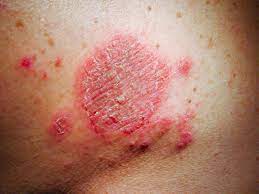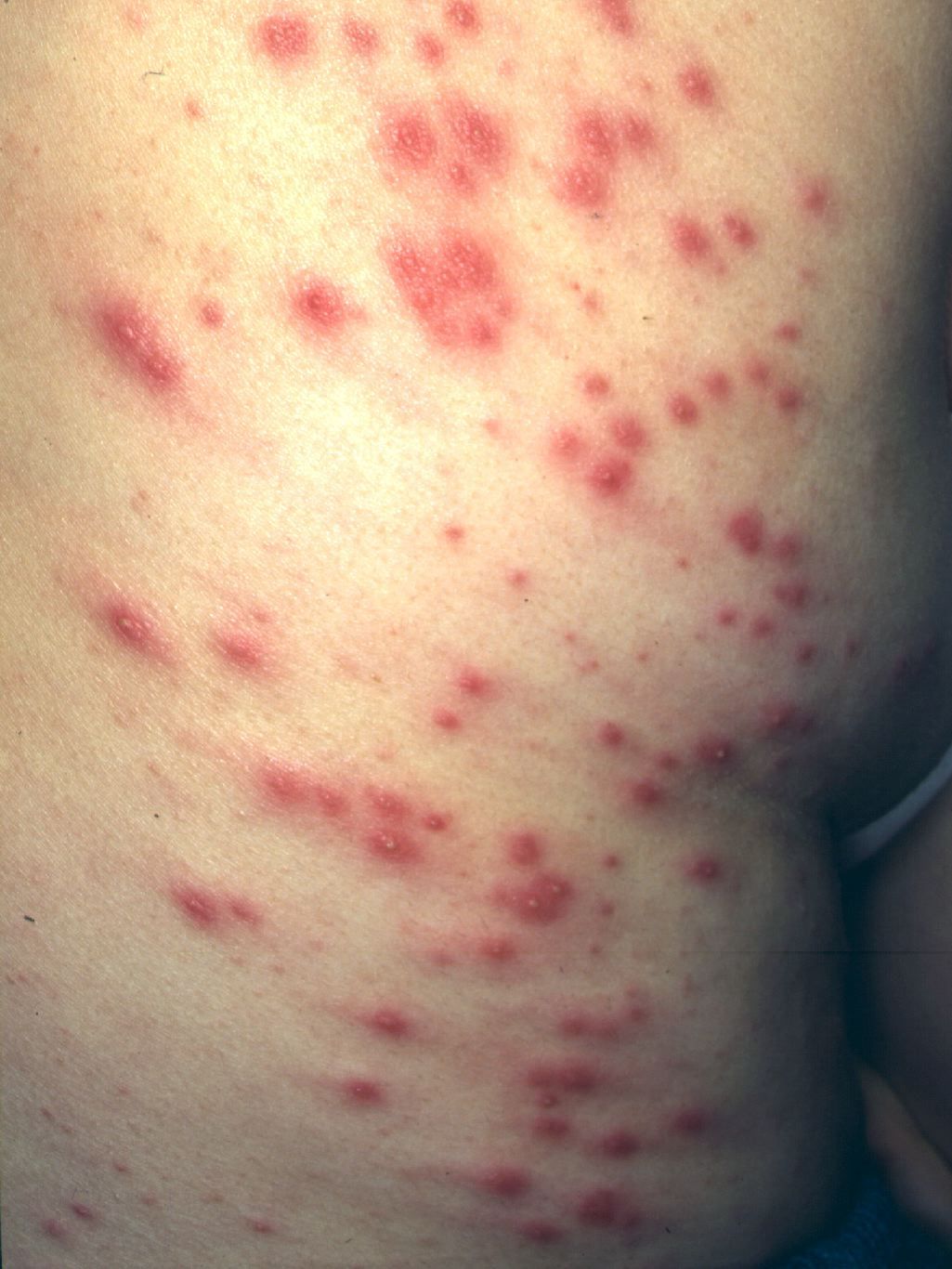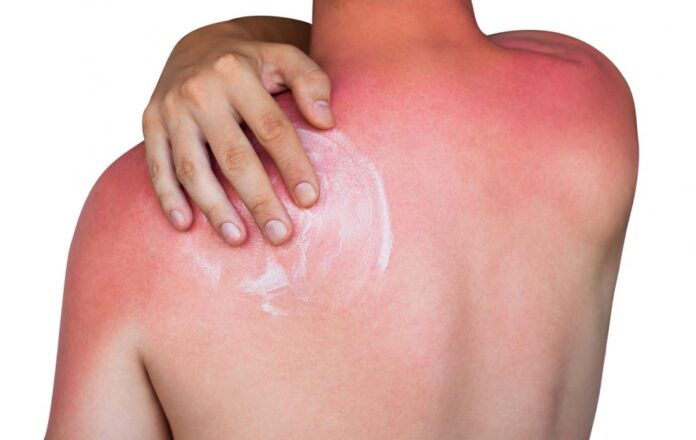Getting a sudden red spot on the neck can be troublesome for a person. This redness can occur suddenly and can also cause an itch, so if you are wondering what has caused this, you are in the right place.
In this article, you can find the reason for this neck redness. Is it a common problem or a severe skin problem? Check out the images and compare them with your redness. if similar, learn about the problem, and you’ll be one step closer to treating your redness in the neck.
Redness in neck
There can be numerous reasons behind the redness in the neck. Generally, this redness is defined into categories: Common problems and Skin Problems
Common Skin Issue that Causes Neck Redness
Sunburn
It is a common cause of redness in the neck. Every person can be affected by sunburn after spending too much time in the sun.
The skin redness is caused by the presence of ultraviolet rays from the sun, and these rays damage the skin.
To stop and repair the burned skin, the human body increases blood flow to that specific area, which ends up resulting in redness in that specific area.

According to research, overexposure to UV rays from the sun can increase the risk of skin cancer, wrinkles, brown spots, and freckles.
For people who have fair or lighter skin, the affected area will turn pink or red, but darker skin tones may become darker.
Check if the redness in the neck is due to Sunburn: The affected area will show these symptoms
- Hot
- Sensitive to the touch
- painful
- irritated
- itchy
- blistered
- Skin peeling
If a person has a severe sunburn, the effect will be all around the body. It will lead to:
- fever
- chills
- headache
- nausea and vomiting
- a general feeling of being unwell
Burns
The redness in the skin can be caused by other burns, like coming in contact with manufactured products. Some types of burns are:
- Thermal burns: If the skin is in contact with a hot substance, near flames, or hot liquids, it is represented as a thermal burn. In a thermal burn, the affected area turns red after a few minutes of contact. If the burn is mild, the redness in the neck should go away after 7-14 days.
- Chemical burns: Exposing yourself to dangerous chemical substances, like bleaches, acids, and detergents, can cause a reaction and redness in the skin.
- Electrical burns: When a person gets an electric shock, for a few hours, the affected area can be red in color. The severity of the electric current determines the effect it will have on the body.
- Friction burns: After scratching the skin continuously for a few minutes, or when the skin is rubbed against a hard surface, the skin appears to be red.
- Radiation burns: Radiation exposure can damage the skin and cause redness in the skin.
The severity of the burn is determined in different class sections:
- First-degree burns are represented as mild burns that usually end up causing only skin redness and itchiness.
- Second-degree and third-degree burns are more severe, where the damage is not limited to a single skin layer but to several layers of skin.
- Fourth-degree burns are the most severe burns that are caused when the bones and muscles are affected due to a specific type of burn.
Related: Can I workout after botox?
Heat Rash
Heat rash, also referred to as prickly heat or miliaria, is a common skin condition that occurs due to overheating.
This condition is developed when the body is overheating due to hot or humid weather, and the pores accidentally trap perspiration under the skin.
This results in blisters, red lumps, and redness. The most affected areas due to heat rash are the armpits, face, and neck.
This condition is not severe and is treated without any medications. Although the patches of bumps this condition creates are uncomfortable and may create an itching and stinging sensation
These small pimples are cured when the body cools off, but these can last up to 5-7 days, depending on the person’s body type and environmental conditions.
Related: How Long Does Ear Infection Last
Skin Problems cause redness in the neck
Dermatitis
Dermatitis is made from “dermatitis,” “derm” means “skin,” and “itis” means “inflammation.” It means “inflammation of the skin.”
Dermatitis can be caused by genetics, an overactive immune system, infections, allergies, irritating substances, etc.
If a person is suffering from dermatitis, there will be rashes, irritation, Dry skin, Fluid-filled blisters, Thickening, hardening, and swelling of the skin, and Crusting, scaling, or creasing of the skin. The symptoms can range from mild to severe, depending on the type of dermatitis.

The good thing about dermatitis is that it is not contagious, and it does not cause severe health problems or skin issues. It can be easily treated with certain medication and proper precautions.
Some common types of dermatitis that can cause redness in the neck are:
- Contact dermatitis: This variant of dermatitis is activated when the body is in direct contact with an irritant or allergen. This causes itchiness and redness on the skin. This doesn’t last long, possibly for 10-15 days by taking proper precautions and medications.
- Atopic dermatitis: Also referred to as atopic eczema, this variant is more severe as it is a long-term skin issue. In most cases, children are affected by this variant. Children above the age of 2 years are at the highest risk of getting this dermatitis. This also causes rash, itchiness, dry skin, fluid-filled blisters, and redness in the neck and scalp.
- Seborrheic dermatitis: This variant is most common among people who have too many oil-producing glands. The skin causes redness on the scalp, chest, neck, and head.
How long will redness last: The duration of the redness and itchiness is different for every type of dermatitis. If a person is suffering from mild dermatitis, the redness, swelling, itchiness, and rashes can be cured within 10- 15 days with proper treatment.
Related: How To Tell If Chest Pain Is Muscular
Folliculitis
If you see red patches around the hair follicles, you are suffering from folliculitis. In this condition, the skin around the hair Follicles is inflamed. This inflammation can occur due to bacterial or fungal infection, but sometimes, these occur after improper shaving of the hairs.

During Folliculitis, there will be bumps on the affected area, and these can create itchiness, rash, and redness. Also, sometimes, this will lead to pus-filled blisters, which can create severe itchiness. If you are suffering from this, the mild cases are self-treatable, but in severe conditions, and are in dire need of antibiotics.
These can last up to 5-6 days, and if it is a severe condition, this will last up to 10-15 days.
Related: Feeling tired after sleep
Rosacea
If you notice redness on your cheeks, nose, forehead, and neck, and it looks blushing, with a hint of small bumps, you might be affected with rosacea.
This is a common condition that is most popular among middle-aged women. The first sign of rosacea is redness of the skin, including cheeks, nose, forehead, neck, and sometimes chest, too.

The cause of rosacea is unknown, but it can be generated through environmental factors, a bad immune system, and sometimes poor hygiene.
Although this is not a serious medical issue, it can last a lifetime. However, if the rosacea is in severe condition, it can create skin problems, such as
- Facial blushing or flushing: There can be constant redness on the cheeks around the nose and also on the neck, and these can last a lifetime without proper treatment.
- Visible veins: Blood vessels on the face are sometimes visible, which can cause uneven skin.
- Swollen bumps: Acne can occur due to rosacea and pus-filled pimples.
- Burning sensation: During the day, there will be a burning sensation on the face.
- Eye problems: If a person is suffering from rosacea, he will constantly experience dry, irritated, and swollen eyes and eyelids.
- Enlarged nose: After a certain duration, rosacea causes the thickening of the nose skin and causes it to look bigger.
Related: Can you eat cauliflower leaves?
Psoriasis
Psoriasis is a long-term (chronic) skin disease with no cure. This causes red, itchy, scaly patches on the neck, elbows, and scalp. This disease goes through a cycle, where the disease will flare for a few weeks, and then after a certain time, it will again come, with more severity.

Psoriasis is caused due to immune system problems, which alter the time cycle of the regeneration of the cells. The generation period of new cells is increased, and this rapid pace results in red patches on different areas of the body.
Check out the images to fully understand whether you are affected by psoriasis.
Related: Best food for your skin
Shingles
Shingles is a viral infection that causes a stripe of red blisters on the skin. Shingles are caused by the varicella-zoster virus, which is responsible for chickenpox.
After the chickenpox cycle, the virus moves to the nerve tissue, and due to the lower immune systems, it is again activated, which results in shingles.
Shingles create a burning sensation, which is very painful, and small blisters and pus fill, which creates irritation.

Shingles are contagious, and the varicella-zoster virus can be transferred to anyone who isn’t immune to chickenpox. After getting in contact, the affected person will experience chickenpox, not shingles.
Related: Is it ok to eat avocado everyday
Lupus
Lupus is a chronic condition that occurs when the immune system mistakenly attacks the body’s organs and tissues.
This skin condition creates a red rash around the face and neck area. The first sign of lupus is a ring-shaped rash on both cheeks.
The condition ranges from mild to severe, where the mild cases can be cured in 10-15 days, and the severe cases can take a few months.
Symptoms of lupus are:
- Fatigue
- Fever
- Joint pain, stiffness, and swelling
- Wing-shaped face rash
- Skin lesions get worse due to sun exposure.
- Shortness of breath
- Chest pain
- Dry eyes
- Headaches, confusion, and memory loss
- Redness in the neck.
Conclusion
There are numerous reasons behind the ren neck, and sometimes it can be mild, but it can be severe to health too. These can be treated at home using OTC products or natural treatments. However, if severe, it may be necessary to see a doctor.
A person with persistent skin redness symptoms should see a doctor or a dermatologist and not rely on home remedies.









